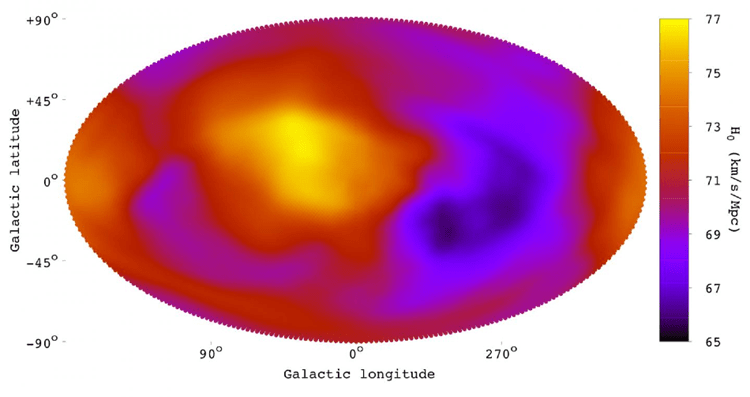Apr 9 2020
Regardless of the location, the same rules are applicable to any place in space: this basic principle is used for numerous calculations of astrophysics. However, recent research by scientists from the Universities of Bonn and Harvard has raised questions about the applicability of this principle.
 The blue areas expand more slowly than expected, the yellow areas faster. In isotropy, the image would be monochromatic red. Image Credit: © Konstantinos Nikolaos Migkas, Uni Bonn/Astronomy & Astrophysics.
The blue areas expand more slowly than expected, the yellow areas faster. In isotropy, the image would be monochromatic red. Image Credit: © Konstantinos Nikolaos Migkas, Uni Bonn/Astronomy & Astrophysics.
If the measured values are confirmed, several assumptions about the properties of the universe would be thrown overboard. The study outcomes were reported in the Astronomy & Astrophysics journal, but are already available online.
Ever since the big bang occurred, the universe has expanded similar to a freshly formed raisin roll placed in a warm place to rise. To date, this increase in size was considered to occur uniformly in all directions, as in the case of a good yeast dough. This has been named “isotropy” by astrophysicists.
Several calculations on the basic properties of the universe are performed based on this assumption. Convincing observations and analyses conducted by the researchers from the Universities of Bonn and Harvard could prove they are all wrong—or at least, inaccurate.
This is because, for the first time, the researchers have tested the isotropy hypothesis using a new method that enables more reliable statements than before. And the result is unpredicted: As per this method, certain regions in space expand quicker than expected, while others expand more slowly than they should.
“In any case, this conclusion is suggested by our measurements,” noted Konstantinos Migkas, from the Argelander Institute for Astronomy at the University of Bonn.
As part of their study, Migkas and his collaborators have created a new, efficient isotropy test, which is based on the observation of what are called galaxy clusters—or, the raisins in the yeast bun. The clusters release X-ray radiation that can be gathered on Earth (here, this was performed by the satellite-based telescopes XMM-Newton and Chandra).
It is feasible to calculate the temperature of the galaxy clusters based on specific properties of the radiation. In addition, their brightness can be quantified. Their brightness is directly proportional to how hot they are.
A simple rule applies in the case of an isotropic universe. The further a celestial object is located from the earth, the quicker it travels away from Earth. Thus, knowing its speed, its distance from the earth can be deduced, irrespective of the direction in which the object is located. To date, this has been the belief of researchers.
In reality, however, our brightness measurements seem to disagree with the above distance calculation.
Konstantinos Migkas, Argelander Institute for Astronomy, University of Bonn
This is because with the increase in distance, the amount of light that arrives at the earth decreases. Therefore, with the knowledge of a celestial body’s original luminosity and its distance, researchers must know how bright it would shine in the telescope image.
Moreover, it is exactly at this point that researchers have found discrepancies that are challenging to set right with the isotropy hypothesis— that certain galaxy clusters are considerably fainter than predicted. They are possibly located at a much greater distance from Earth than calculated from their speed. However, for some others, the opposite is the case.
“There are only three possible explanations for this,” notes Migkas, who is currently pursuing his doctorate in the research group of Prof. Dr Thomas Reiprich at the Argelander Institute.
Firstly, it is possible that the X-ray radiation, whose intensity we have measured, is attenuated on its way from the galaxy clusters to Earth. This could be due to as yet undiscovered gas or dust clouds inside or outside the Milky Way. In preliminary tests, however, we find this discrepancy between measurement and theory not only in X-rays but also at other wavelengths.
Konstantinos Migkas, Argelander Institute for Astronomy, University of Bonn
Migkas added, “It is extremely unlikely that any kind of matter nebula absorbs completely different types of radiation in the same way. But we won’t know for sure for several months.”
Another possibility is the so-called “bulk flows”—groups of adjacent galaxy clusters that travel continuously in a specific direction—for instance, under the influence of certain structures in space that produce strong gravitational forces. Thus, these would attract the galaxy clusters toward themselves and alter their speed (and consequently their derived distance).
This effect would also mean that many calculations on the properties of the local universe would be imprecise and would have to be repeated.
Konstantinos Migkas, Argelander Institute for Astronomy, University of Bonn
The third possibility is the most crucial one: What if the universe is not isotropic at all? What if—in figurative terms—the yeast in the galactic raisin roll is so non-uniformly distributed that it rapidly bulges in certain places and barely grows in other areas? An anisotropy such as this could, for instance, be the outcome of the characteristics of the enigmatic “dark energy,” which serves as a further driving force for the expansion of the universe.
But there is still a lack of a theory that would render the behavior of the dark energy consistent with the observations. “If we succeed in developing such a theory, it could greatly accelerate the search for the exact nature of this form of energy,” hopes Migkas.
This study is based on information collected from over 800 galaxy clusters, 300 of which were studied by the authors. The rest of the clusters are from previously reported studies. The analysis of the X-ray data alone took several months, as it was quite challenging.
It is predicted that in the coming years, the new satellite-based eROSITA X-ray telescope will record several thousand more galaxy clusters. Soon, it will be evident whether the isotropy hypothesis should really be abandoned.